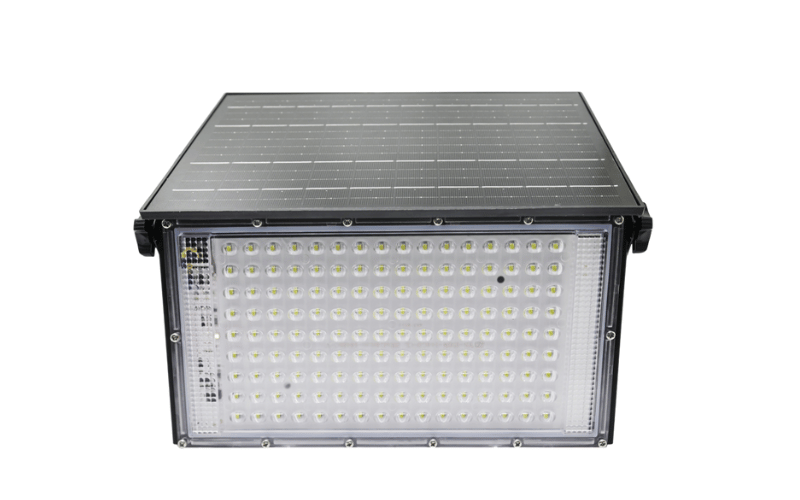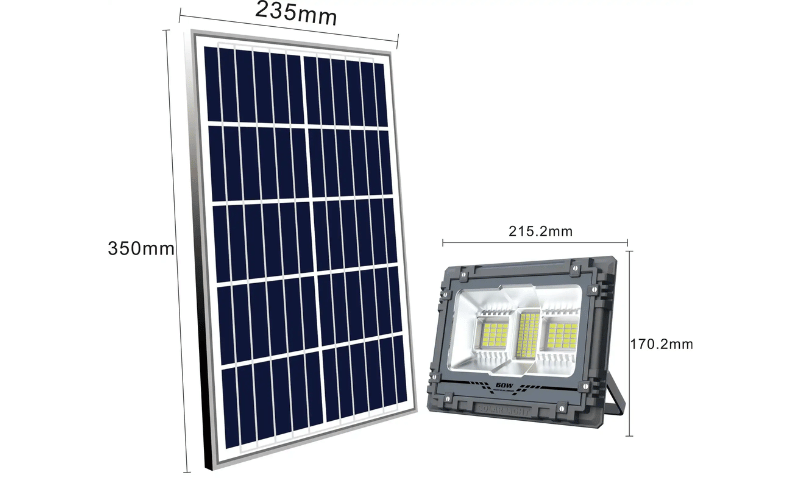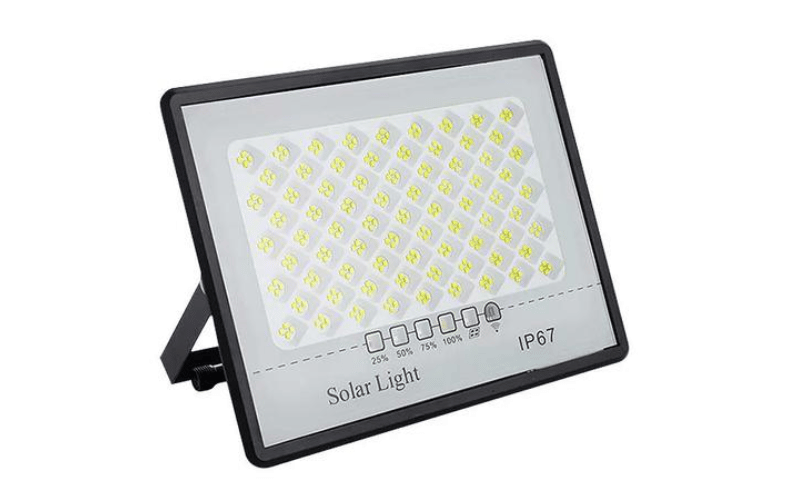Solar flood lights are revolutionizing outdoor lighting by offering an eco-friendly, cost-effective, and versatile solution. These lights harness the power of the sun to provide reliable illumination, making them ideal for enhancing security, reducing energy costs, and improving outdoor spaces. Whether you’re lighting up a backyard, driveway, or garden path, solar flood lights combine advanced technology with practical features to meet a variety of needs. However, like any product, they come with their own set of pros and cons, which are essential to consider before making a purchase.
Table of Contents
ToggleHow Solar Flood Lights Work
Solar flood lights are an eco-friendly and cost-effective lighting solution that uses sunlight to power bright, reliable illumination. They combine advanced technology with simple components to provide consistent performance, even in low-light conditions.
1. The Solar Power Process
- Sunlight hits solar panels: Solar panels, made of photovoltaic (PV) cells, absorb sunlight and convert it into direct current (DC) electricity. The efficiency of this process depends on the quality and size of the solar panel.
- Panels convert light to electricity: The DC electricity generated is sent to a charge controller, which regulates the flow of energy to prevent overcharging.
- This powers an internal battery: The electricity is stored in a rechargeable battery, typically lithium-ion, which is known for its durability and efficiency.
- The battery stores energy for nighttime: Once the sun sets, the stored energy powers the LED lights, ensuring consistent illumination throughout the night.
2. Key Components
- Solar Panel: Captures sunlight and converts it into electricity. Larger panels or those with higher efficiency ratings generate more power, making them ideal for areas with limited sunlight.
- Battery: Stores the electricity generated during the day. Lithium-ion batteries are preferred for their long lifespan and faster charging capabilities compared to lead-acid batteries.
- LED Light: Provides bright, energy-efficient illumination. Look for LEDs with high lumens for better brightness, but keep in mind that brighter LEDs consume more power.
- Motion Sensor (Optional): Detects movement and activates the light only when needed, conserving battery power and extending the light’s operational time.
- Housing: Protects the internal components from weather conditions like rain, snow, and extreme temperatures. Durable materials like aluminum or high-grade plastic ensure longevity.
The Pros: Why Solar Flood Lights Shine
Solar flood lights are a smart investment for anyone looking to save money, reduce their environmental impact, and improve safety. They combine practicality with ease of use, making them a popular choice for homes and businesses alike.
Cost Savings
- Zero electricity costs: Solar flood lights rely entirely on sunlight, eliminating monthly energy bills. For example, replacing a traditional 150-watt floodlight with a solar-powered one can save up to $50 annually in electricity costs.
- No need for complex wiring: Since they don’t require connection to the electrical grid, you save on professional installation fees, which can range from $100 to $500 per light.
- Think of the money saved over time: With minimal maintenance and no ongoing energy costs, solar flood lights pay for themselves within a few years.
Environmental Benefits
- Uses clean, renewable energy: Solar lights harness the power of the sun, reducing reliance on fossil fuels. This makes them a sustainable choice for eco-conscious users.
- Reduces your carbon footprint: A single solar flood light can prevent the release of approximately 200 pounds of CO2 annually, equivalent to planting two trees.
- Good for the planet: By choosing solar, you contribute to a greener future and help combat climate change.
Easy Installation
- Mount them yourself: Most solar flood lights come with user-friendly mounting kits, allowing you to install them with basic tools like a screwdriver.
- Place them where you need light: Unlike wired lights, solar flood lights can be installed anywhere with sufficient sunlight, such as fences, walls, or garden posts.
- Flexibility is key: Many models feature adjustable panels and lights, so you can direct the illumination exactly where it’s needed.
Safety and Security
- Deters intruders: Bright, motion-activated lights are a proven deterrent for burglars and trespassers. Studies show that well-lit areas are less likely to be targeted.
- Improves visibility around your home: Illuminate pathways, driveways, and entrances to reduce the risk of trips and falls, especially in poorly lit areas.
- Motion-activated lights add an extra layer of security: These lights only turn on when movement is detected, alerting you to potential activity while conserving battery power.
The Cons: Where Solar Flood Lights Fall Short
While solar flood lights offer many benefits, they do come with some limitations. Understanding these drawbacks can help you make an informed decision and set realistic expectations.
Weather Dependency
- Cloudy days mean less charging: Solar panels rely on direct sunlight to generate power. Overcast weather can significantly reduce their efficiency, leading to dimmer lights or shorter runtimes.
- Long, dark winters are a challenge: In regions with extended winters or limited daylight hours, solar flood lights may struggle to charge fully, resulting in weaker performance.
- Heavy rain or snow can block panels: Accumulated snow, dirt, or water on the panels can obstruct sunlight, so regular cleaning or clearing is necessary to maintain functionality.
Light Intensity and Duration
- Brightness may not match wired lights: Budget-friendly solar flood lights often have lower lumen output, which means they may not be as bright as traditional wired options.
- Battery life limits how long they stay on: Depending on the battery capacity and charge level, some lights may only last a few hours after sunset, especially in high-use areas.
- Compare lumen output for desired brightness: When shopping, check the lumen rating to ensure the light meets your needs. Higher lumens mean brighter light but may drain the battery faster.
Initial Cost
- Some higher-quality models are pricey upfront: While solar flood lights save money in the long run, premium models with better performance and durability can have a steep initial cost.
- You get what you pay for: Cheaper models may seem appealing but often come with compromises in brightness, battery life, or durability. Investing in a reliable brand can save you from frequent replacements.
Maintenance Needs
- Keep solar panels clean: Dust, dirt, and debris can accumulate on the panels, reducing their ability to absorb sunlight. Regular cleaning ensures optimal performance.
- Batteries degrade over time: Rechargeable batteries have a limited lifespan and will eventually need replacement, typically every 2-5 years depending on usage and quality.
Making the Right Choice: What to Look For
Choosing the right solar flood light involves understanding key features that impact performance, durability, and usability. Here’s what to consider to ensure you get the best value for your investment.
Panel Size and Efficiency
- Bigger is generally better for charging: Larger solar panels can capture more sunlight, which means faster and more efficient charging, especially in areas with limited daylight.
- Look for monocrystalline panels: These are the most efficient type of solar panels, converting more sunlight into electricity compared to polycrystalline or thin-film panels. They’re ideal for maximizing performance in smaller spaces.
Battery Capacity
- Measured in mAh (milliampere-hours): A higher mAh rating means the battery can store more energy, allowing the light to stay on longer during the night. For example, a 4000mAh battery can typically power a light for 8-10 hours.
- Consider how long you need light: If you need illumination throughout the night, opt for a light with a larger battery capacity. For occasional use, a smaller battery may suffice.
Lumen Output
- This measures brightness: Lumens indicate how bright the light will be. Higher lumens mean brighter light, but they also consume more battery power.
- Match lumens to your needs: For general outdoor lighting, 500-1000 lumens is common. For security purposes, consider lights with 1500 lumens or more to ensure maximum visibility.
Durability and Weatherproofing
- Look for IP ratings (e.g., IP65): The Ingress Protection (IP) rating indicates how well the light is protected against dust and water. An IP65 rating means it’s dust-tight and can withstand heavy rain, making it suitable for outdoor use.
- Choose sturdy, rust-resistant materials: Aluminum or high-grade plastic housings are ideal for withstanding harsh weather conditions and ensuring long-term durability.
Sensor Features
- Adjustable motion detection range: Some lights allow you to customize the range and sensitivity of the motion sensor, ensuring it only activates when needed and saves battery power.
- Dusk-to-dawn settings: These lights automatically turn on at sunset and off at sunrise, providing hassle-free operation and energy efficiency.
Real-World Performance and Expert Views
Solar flood lights have proven to be a practical and versatile solution for many homeowners, offering both cost savings and convenience. Here’s a closer look at how they perform in real-life scenarios and what experts have to say.
Case Study: Backyard Transformation
- The Miller family installed solar flood lights: Seeking an affordable way to enhance their outdoor space, the Millers opted for solar-powered lights to illuminate their backyard.
- They lit up their patio and garden path: The lights provided a warm, inviting glow along their garden path and patio, making the space more functional and enjoyable after dark.
- Enjoyed evenings outdoors without high bills: By using solar energy, the family avoided the added expense of electricity, allowing them to enjoy their outdoor space guilt-free.
- “They’ve made a huge difference,” says Sarah Miller: Sarah highlights how the lights have improved their backyard’s ambiance and safety, making it a favorite spot for family gatherings.
Expert Insight: Lighting Designer
- “For general security lighting, solar is great,” notes an industry pro: Solar flood lights are ideal for areas where you need reliable, eco-friendly illumination without the hassle of wiring.
- “But for task lighting or areas needing constant bright light, wired is often superior”: Experts recommend wired lighting for spaces like workshops or garages where consistent, high-intensity light is essential.
- “Choose based on your specific need”: The key is to evaluate your requirements—solar lights excel in flexibility and cost savings, while wired options are better for demanding tasks.
Solar flood lights are a versatile option, but understanding their strengths and limitations ensures you make the right choice for your space.
Actionable Takeaways: Are They Good For You?
Solar flood lights can be a fantastic choice for many situations, but they aren’t a one-size-fits-all solution. Here’s a breakdown to help you decide if they’re the right fit for your needs.
Yes, if:
- You need basic security lighting: Solar flood lights are perfect for deterring intruders and lighting up entryways, driveways, or garden paths.
- You want to save on electricity: Since they rely on sunlight, you’ll enjoy zero energy costs, making them an eco-friendly and budget-friendly option.
- Easy installation is a priority: With no wiring required, you can set them up yourself in minutes, even in areas far from power outlets.
- Brightness needs are moderate: If you’re looking for functional lighting rather than stadium-level brightness, solar flood lights will meet your expectations.
Maybe not, if:
- You need very bright, constant light: For tasks requiring high-intensity, uninterrupted lighting, wired flood lights are a better choice.
- Your area has very little sun: Regions with frequent cloudy weather or long winters may not provide enough sunlight to keep the lights fully charged.
- You expect them to last forever without battery changes: While durable, the batteries in solar lights will eventually need replacement, typically every 2-5 years.
Understanding your specific needs and environment will help you determine if solar flood lights are the right solution for you.
Frequently Asked Questions
Q: How do solar flood lights work?
A: Solar flood lights use photovoltaic (PV) cells in their panels to absorb sunlight and convert it into direct current (DC) electricity. This electricity charges a built-in battery during the day. At night, the stored energy powers LED lights, providing consistent illumination.
Q: Are solar flood lights bright enough for security purposes?
A: Yes, many solar flood lights are bright enough for security. Look for models with higher lumen ratings, typically 1000 lumens or more, to ensure sufficient brightness. Motion-activated features also enhance security by startling intruders.
Q: Do solar flood lights work during cloudy or rainy days?
A: Solar flood lights can work on cloudy or rainy days, but their performance may decrease due to reduced sunlight. High-efficiency panels and larger batteries can help maintain functionality in such conditions.
Q: How long do solar flood lights last at night?
A: The runtime depends on the battery capacity and the amount of sunlight the panels receive during the day. Most solar flood lights last between 6 to 10 hours on a full charge.
Q: What maintenance do solar flood lights require?
A: Regularly clean the solar panels to remove dust, dirt, or debris that can block sunlight. Check the battery periodically, as it may need replacement every 2-5 years, depending on usage and quality.
Q: Can I install solar flood lights myself?
A: Yes, most solar flood lights come with simple mounting kits and require no wiring. You can easily install them using basic tools like a screwdriver.
Q: Are solar flood lights weatherproof?
A: Many solar flood lights are designed to withstand outdoor conditions. Look for models with an IP65 rating or higher to ensure protection against dust and heavy rain.
Q: How do I choose the right solar flood light?
A: Consider factors like panel size, battery capacity, lumen output, and weatherproofing. Match the light’s features to your specific needs, such as security, ambient lighting, or task lighting.
Q: Do solar flood lights save money?
A: Yes, solar flood lights eliminate electricity costs and reduce installation expenses since they don’t require wiring. Over time, they pay for themselves through energy savings.
Q: Can solar flood lights work in areas with limited sunlight?
A: Solar flood lights can work in areas with limited sunlight, but their performance may be reduced. Choose models with high-efficiency panels and larger batteries to compensate for less sunlight.
Concluding Summary
Solar flood lights are a practical choice for those seeking affordable, energy-efficient, and easy-to-install outdoor lighting. They excel in providing basic security and ambient lighting while reducing electricity costs and environmental impact. However, they may not be suitable for areas with limited sunlight or for tasks requiring constant, high-intensity illumination. By understanding their strengths and limitations, you can determine if solar flood lights are the right fit for your specific needs.




